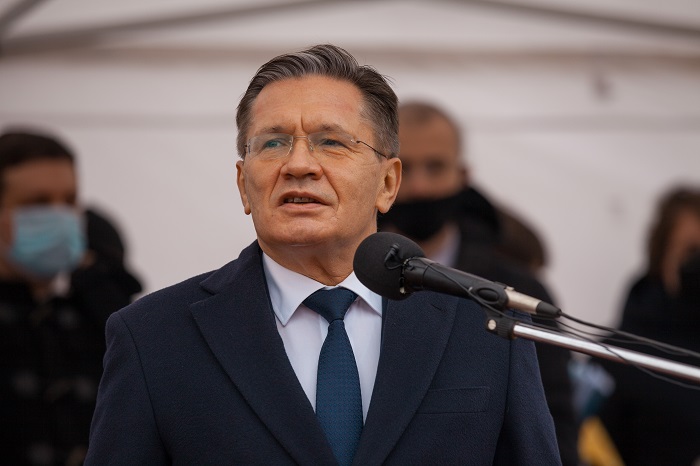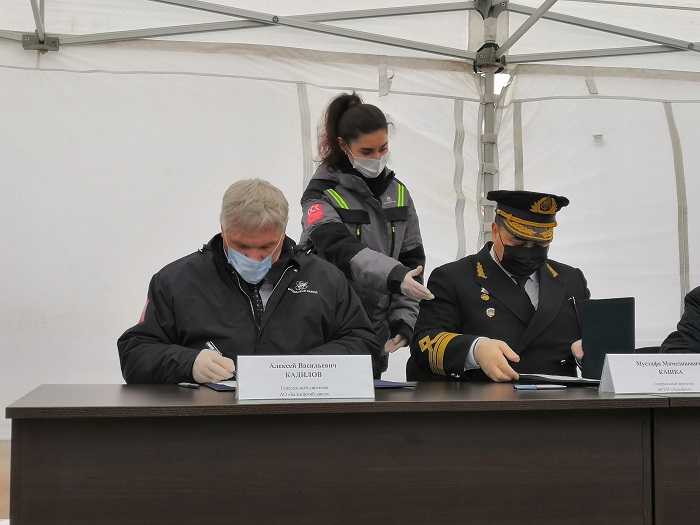On December 16, the keel for the fifth (fourth serial) Project 22220 nuclear icebreaker Chukotka was laid at the Baltic Shipyard in St Petersburg.
Roman Kopin, the Governor of the Chukotka Autonomous Okrug, Alexey Likhachev, Director General of ROSATOM, Evgeny Elin, Vice Governor of St. Petersburg, Vyacheslav Ruksha, Deputy Director General and Director of the Northern Sea Route Directorate of ROSATOM, Vladimir Egorov, Deputy Director of nuclear ships Department of Russian Maritime Register of Shipping, David Adamia, Vice President of the United Shipbuilding Corporation, Mustafa Kashka, Director General of FSUE Atomflot and Aleksey Kadilov, Director General of the Baltic Shipyard attended the ceremony.
“In recent history of the Baltic Shipyard there hasn’t been a series of nuclear icebreakers like this, five vessels of the same project,” Alexei Kadilov said in the opening speech. He thanked the enterprise personnel as well as ROSATOM as the customer for its trust.

“The new series of icebreakers is a triumph of engineering thought. These are the most powerful and most efficient icebreakers on the planet today. We are proud with the constant increase in the share of the Russian components. I am sure that there will be a lot of new innovative solutions in the future,” Alexey Likhachev noted.
“Icebreakers of this type are needed for stable operation of the Northern Sea Route and for the transition of the region from the dependence on short Arctic navigation to year-round cargo delivery. This will have a great impact on the quality of life and the implementation of investment projects,” Roman Kopin said.
“Today, yet another keel of a serial icebreaker has been laid down. This is the confirmation of high professionalism of the employees involved. We have no doubts that this order will be completed with the required quality and on time,” Evgeny Elin commented.
“Today, the fifth nuclear icebreaker of the series 22220, named Chukotka, has been laid down. It means that we are preparing for the year-round navigation along the entire Northern Sea Route. Secondly, it shows that we have successfully overcome the obstacle of replacing the existing nuclear icebreakers with new, more powerful and modern ones, without disrupting large projects under implementation in the Arctic. New investors can confidently start their projects since the nuclear-powered icebreaking capacity will be sufficient for the next 40 years. And by that time a new generation of nuclear-powered icebreakers will already appear,” Vyacheslav Ruksha said.
“Nuclear-powered icebreakers of the project 22220 will become the basis of a modern nuclear icebreaker fleet,” said Mustafa Kashka. “The lead universal nuclear-powered icebreaker Arktika completed its first mission in Northern Sea Route waters. The crew of the vessel fully completed the tasks assigned. I have no doubt that during the construction of the fifth nuclear icebreaker Chukotka the shipbuilders will take into account the experience of the previous nuclear-powered ships of project 22220 construction and give us an icebreaker that meets all the declared characteristics.”

Traditionally, a storm board was installed on the bottom of the vessel; the board was installed by Roman Kopin, the Governor of the Chukotka Autonomous Okrug, Alexey Likhachev, Director General of ROSATOM, David Adamia, Vice President of the United Shipbuilding Corporation and Mustafa Kashka, Director General of FSUE Atomflot.
The act on the fifth nuclear project 22220 icebreaker Chukotka keel laying was signed by Mustafa Kashka, Vladimir Egorov and Aleksey Kadilov.
Operational commissioning of the nuclear icebreaker Chukotka is scheduled for December 2026.
For reference:
The contract for the construction of the 3rd and 4th serial nuclear icebreakers was signed between FSUE Atomflot and the Baltic Shipyard in August 2019. The contract value is 100 billion rubles.
The fourth serial nuclear icebreaker Chukotka is designed for independent pilotage of ships, including large-capacity ones, and for leading the fleet in the Western Arctic region. The vessel’s dual-draft concept allows for operating it both in the Arctic and in the mouths of the polar rivers, in particular in shallower areas of the Yenisei estuary and the Ob Bay area.
Iceberg Central Design Bureau designed the technical project of the icebreaker in 2009. The icebreaker is equipped with specially designed two new generation RITM-200 reactors and a steam turbine unit with an overall power capacity of 175 MW. RITM-200 is an innovative and unique design developed by of one of the oldest design bureaus of the nuclear industry - OKBM Afrikantov (Nizhny Novgorod, part of JSC Atomenergomash). The rich experience of the construction and operation of reactors for nuclear icebreakers as well as modern trends of the world nuclear power engineering were the basis for the design of RITM-200. It includes two reactors with the capacity of 175 megawatts each. RITM-200 is almost twice as light and compact as previous reactors, therefore it is cheaper in terms of material intensity and takes less space on the vessel and thus more economically efficient. Such a solution is structurally achieved due to the fact that steam generators, which were previously located outside the reactor, are now located directly in it, which is called an integrated layout.
Main characteristics of the vessel: length: 173,3 meters (160 m, dwl); width: 34 meters (33 m, dwl); height - 15.2 meters; power capacity: 60 mw (on propeller shafts); cruising speed: 22 knots (in clear water); draft - 10.5 meters/8.65 meters; maximum ice penetration - 2.9 meters; displacement - 33 540 tons; estimated service life - 40 years; number of crew - 53 people.
The 1st serial nuclear icebreaker “Sibir”, the 2nd serial nuclear icebreaker “Ural” and the 3rd serial nuclear icebreaker “Yakutia” are under construction at the Baltic Shipyard.
